
James Bridle is the creator of bold artistic interventions into the contemporary drone debate. He is perhaps best known for his Drone Shadows, 1:1 scale paint outlines of U.S. military drones, which he has painted on sidewalks, roadways, and parking lots in the U.K., Turkey, Norway and the U.S. His Drone Shadow in Washington, D.C., which he painted for an exhibition at the Corcoran Gallery, was installed adjacent to the guest entrance of the White House. Bridle has pointed out that thousands of tourists who visited the White House in the three-month period of the exhibition practically had to walk over his outline of an MQ-9 Reaper drone. Bridle is also the creator of Dronestagram, which publishes satellite images of the locations of U.S. drone strikes. As a result of these and other works of drone art, Bridle has become a leading voice in the current effort to make sense of the drone within the cultural and aesthetic space. A former publisher who is trained in computer science, Bridle speaks with remarkable confidence and eloquence on a wide range of topics, including networked technology, surveillance and the New Aesthetic, a term he coined for the visual signature of digital intrusions into real, material life.
James Bridle’s art and writing have appeared widely. He is currently a featured artist in the Museum of Modern Art’s “Design and Violence” series. He has been written about inThe Atlantic, The Huffington Post, Vanity Fair and The New Yorker, among other publications. His ongoing work can be followed on his website. During a recent visit to the U.S., Bridle sat down with Arthur Holland Michel at a Chelsea art gallery to discuss his work.
Interview by Arthur Holland Michel
Center for the Study of the Drone How does the drone fit into the broader themes in your work?
James Bridle I was really fascinated with drones for a long time, but I didn’t know why, and I was very suspicious of my own interest in them. I’m a pacifist and blah blah blah, but I’m also a twelve-year-old boy. And, well, I like flying robots. But I wasn’t sure why I was interested in them. I was probably thinking about them for a good year before I wrote about them or did any kind of work about them, because I wanted to be very sure that I was drawing attention to them for the right reasons. The first set of reasons, I realized, for why they’re important to me is because at the time I was doing a whole lot of work about trying to find ways of talking about technology, quite particularly invisible technologies, by which I mean things that you can’t see or touch but are ever present around us. For example, the internet, but also a whole bunch of subsidiary network technologies as well.
After thinking about the drones for so, so long, I suddenly realized that they represented all of those invisible technologies. They have an incredibly direct, powerful effect on the world, but in terms of military drones—which is really what I’m interested in—they’re also invisible to most people. And the way in which that invisibility operates in the world, what it permits and the forms that it takes, that’s something that you can use to explain how much of technology works. You can talk about the drones and what they do and why it’s important to talk about what they do, but you can also use them as a way of talking about technology in general.
Drone That being said, there are those who contend that drones—and by extension, invisible technologies—are purely a policy issue. That if you want to have any substantive change in that space, you have to look at policy questions and you have to look at data. Where does the artistic discourse fit into that?
Bridle I’m interested in my work in applying the same kinds of analysis to all of these areas. 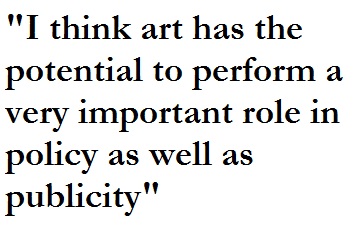 The policy discussion is a highly specialized system with its own language and its own elite—almost a priesthood—who understand it and can explain it. That’s very much the case for law as well. It has its own specialized language, it has its own specialized interpreters, and it’s something that most people will accept as just the way that it is. That is the case for technology, and it’s the case for the law: they behave in the world in very similar ways. So by bringing back that analysis, by demystifying it, by looking at how we can explain it better and have clearer discussions around it, I think art has the potential to perform a very important role in policy as well as publicity.
The policy discussion is a highly specialized system with its own language and its own elite—almost a priesthood—who understand it and can explain it. That’s very much the case for law as well. It has its own specialized language, it has its own specialized interpreters, and it’s something that most people will accept as just the way that it is. That is the case for technology, and it’s the case for the law: they behave in the world in very similar ways. So by bringing back that analysis, by demystifying it, by looking at how we can explain it better and have clearer discussions around it, I think art has the potential to perform a very important role in policy as well as publicity.
Drone But what is the benefit of an artistic intervention over a detailed analysis of, say, the laws of war as they apply to drone operations?
Bridle The artistic intervention is an attempt to render it in ways that make it comprehensible to more people. I think the detailed analysis is incredibly important. But the detailed analysis isn’t going to happen unless there’s pressure for that detailed analysis to be carried out. And that is only going to happen if there is a wide interest in seeing it happen. And even if that detailed analysis were done, everyone would just ignore it unless there were popular pressure to see the recommendations of a direct review of the policy be carried thorough. The debate can’t only happen within specialized disciplines.
It’s the same as how everyone became very concerned about the N.S.A. last year. The debate has been happening within technology circles for quite some time. Most people who work in the field are fully aware of the capabilities of government surveillance and had been talking about it for a while. But nothing happens unless that conversation takes place on a wider level. And for that to happen, you need a non-specialist way of talking about these issues. That’s applicable to military policy, and it’s applicable to network technologies. As more of the world specializes in disciplines—science, law, technology—we disappear into these rabbit holes, but those rabbit holes affect us all because the world is so tightly knitted, largely through network technologies and supranational law and trade and so on and so forth. So the world is more and more knitted together, but it’s ever more knitted together by arcane sciences, essentially. So anything that democratizes the language of those issues seems to me to be the most important thing.
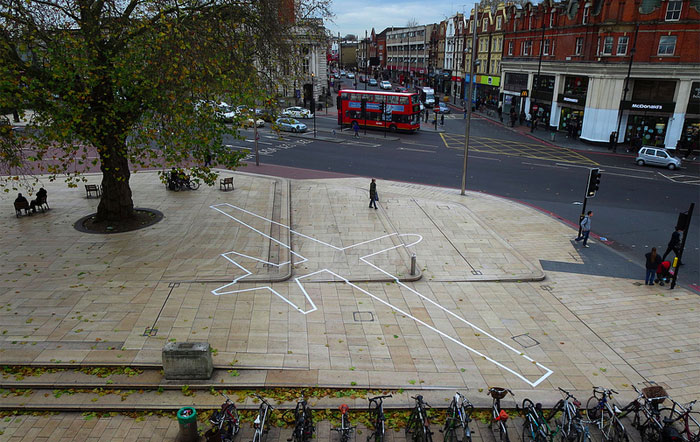
Drone That being said, the discussion that is happening in the creative and artistic sphere seems to distinctly lack a presence that represents those who endorse the use of this technology.
Bridle Yeah.
Drone Do you think that comes at a cost for the dynamism of the artistic discussion?
Bridle I’m nervous to talk about anything with a broad brush ‘as an artist.’ I am quite new to this being an ‘artist’ project, you know. I do a lot of journalism and writing, but I’m quite new to the work that is being done in an art context. There’s benefits to doing it in an art context in that you can get away with more. I want to see the debate happening everywhere. But I also think it must always be informed by other disciplines and perspectives as well.
As an artist, you can delve into law, you can go into policy, you can go into these other areas and you can still keep that overarching view. It seems to work better that way around. So I’m currently being an undercover journalist while pretending to be an artist. Or, I’m being a scientist while claiming to be an artist.
Drone You could imagine that art that idolizes the drone may be a little strange. It may not be aesthetically coherent.
Bridle If it’s idolizing the drone, then it has lost something of what it means to be critical about these things.
Drone It’s more propagandistic than artistic.
Bridle Well, it’s lost itself in a kind of fetishisation of the object rather than what is possible to be done with that object and what are the power structures and so on and so forth. For me, what I’m interested in doing is understanding, structurally, what lies behind everything in our world and interrogating that.
Drone The art that you’ve produced on this subject includes both a consideration of the drone as an object, such as the Drone Shadows, and work that inhabits the drone’s-eye-view. How do you reconcile those two perspectives? Are they separate or are they two sides of the same project?
Bridle The Shadows are not really about what the drone looks like; they’re about the absence of the drone in the contemporary discourse. 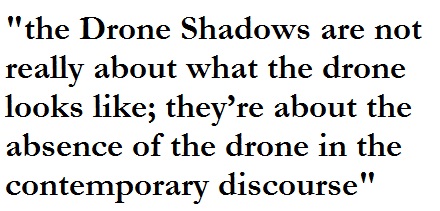 Admittedly, it’s an absence that’s being filled quite quickly now, but a few years ago when I started making them no one was talking about these things. The project was just about how no one knows what these things even look like. There was something that was barely being discussed—-I mean, when it was being discussed, it was discussed with a complete lack of knowledge. So every time we draw a drone shadow, which are 20 or 30 feet across, depending on which drone you draw, the first remark that everyone makes is ‘Oh I had no idea they were so big.’ It’s the most banal statement, and it’s also kind of devastating. How could you not know? It’s a fucking massive metal plane! How could you not know what you’re talking about? It’s brilliant because then people immediately ask, ‘How much else do I not know about this thing? How is this thing so invisible to me? How does it remain invisible to me?’
Admittedly, it’s an absence that’s being filled quite quickly now, but a few years ago when I started making them no one was talking about these things. The project was just about how no one knows what these things even look like. There was something that was barely being discussed—-I mean, when it was being discussed, it was discussed with a complete lack of knowledge. So every time we draw a drone shadow, which are 20 or 30 feet across, depending on which drone you draw, the first remark that everyone makes is ‘Oh I had no idea they were so big.’ It’s the most banal statement, and it’s also kind of devastating. How could you not know? It’s a fucking massive metal plane! How could you not know what you’re talking about? It’s brilliant because then people immediately ask, ‘How much else do I not know about this thing? How is this thing so invisible to me? How does it remain invisible to me?’
So it’s not really about the aesthetics of the plane, it’s about the the visibility of the thing.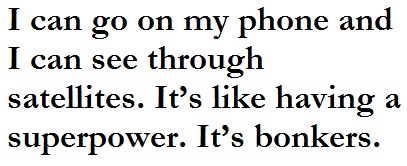 And pointing towards that invisibility. Whereas the Dronestagram project is a critique, not of the drone itself but of the understanding and use of technology, that there’s this thing—drone operations—happening in the world that no one sees. This is larger than the drone program, but the drone program illustrates it very well. There are wars being fought that we don’t see. We’re 150 years into mass media. Even before there was photography, we used to send the illustrators to the battlefield. Now, people are being killed by the U.S. and the U.K. in distant lands and we don’t even have a picture of where that happens. And yet at the same time, we spent the last 20 years building these network services for digital maps and satellite photography that are supposed to illuminate the whole world.
And pointing towards that invisibility. Whereas the Dronestagram project is a critique, not of the drone itself but of the understanding and use of technology, that there’s this thing—drone operations—happening in the world that no one sees. This is larger than the drone program, but the drone program illustrates it very well. There are wars being fought that we don’t see. We’re 150 years into mass media. Even before there was photography, we used to send the illustrators to the battlefield. Now, people are being killed by the U.S. and the U.K. in distant lands and we don’t even have a picture of where that happens. And yet at the same time, we spent the last 20 years building these network services for digital maps and satellite photography that are supposed to illuminate the whole world.
There has been a fundamental disconnect between society and military policy and the techniques of viewing the world which are at our fingertips. I can go on my phone and I can see through satellites. It’s like having a superpower. It’s bonkers. And yet, there’s also this questioning about what we choose to see in the world. Not just the drone itself, but the military actions, the actions of our government. The project is about pointing out that we always have the capability to see, should we choose to pay attention.
Drone Have you actually ever seen a military drone, in the flesh?
Bridle Only in the Air and Space Museum in D.C.
Drone It’s incredible. So many people who work in this area have never seen one.
Bridle My friend and I were sitting one day, and I had made like a little plastic Airfix model of a drone that I bought off the internet. We were holding it, and that was our moment of realizing that we have no idea how big this thing is.
That’s why I started doing them. And I drew the first one purely for my own information. I wanted to know how big they were, and as soon as I saw the effect they had on other people, I thought it might be worth reproducing for other people. But initially, it was for my own benefit, just to get a sense of the damn thing.
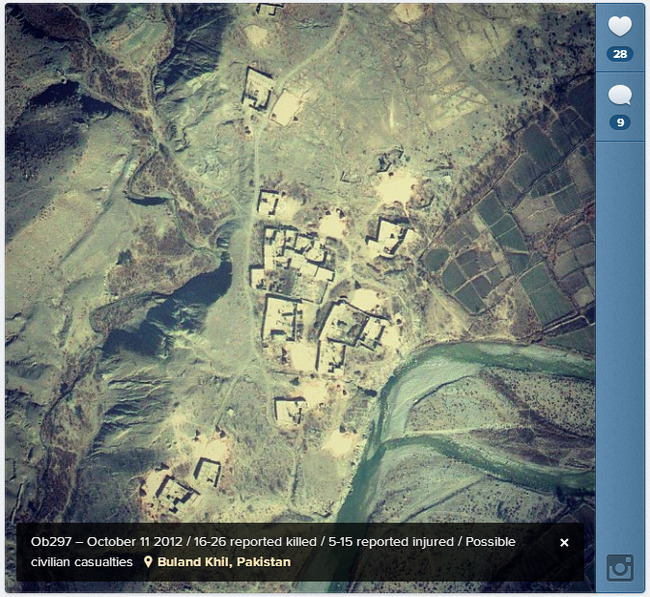
Drone The aerial perspective is a theme that runs through your work, even the material that examines the drone.
Bridle Yes.
Drone What is it about the aerial perspective? What is its allure?
Bridle Well, the aerial view is the perspective that technology has. It’s been the perspective of technology for hundreds of years. The advent of ballooning was the first time we got an aerial perspective of the earth, and from then on it has always been a perspective that has been held by military power. It is the perspective of power. That fact is incredibly revealing about the nature of technology vis à vis the nature of power.  The elevated point of view gives the viewer the illusion of a kind of control or power. Mapping is a method of control. It’s a way in which you freeze the landscape. Throughout history, he who commands the high ground has the power.
The elevated point of view gives the viewer the illusion of a kind of control or power. Mapping is a method of control. It’s a way in which you freeze the landscape. Throughout history, he who commands the high ground has the power.
As soon as you have the elevated viewpoint, the first thing that happens is surveillance and the next thing that happens is weaponization. So first in the American Civil War they had observation balloons, and they started lobbing things out of the balloons. Then they send out these little planes to observe the trenches in the First World War, and it occurs to them that as long as they’re up there, they might as well drop something. Surveillance always becomes weaponized because it is embedded in an inherently unequal power relationship. The ability to see without being seen gives you power. The only use for that power is linked to violence.
Drone And yet, there’s also something very aesthetically appealing about these aerial images.
Bridle Absolutely!
Drone And part of your work shows that there’s a surfeit of incredible images that are quite simply romantic to look at.
Bridle I think that’s true in the sense that I’d never want to demonize technology in any of my work. Technology does give us access to incredible new ways of seeing the world—new forms of beauty and new ways of understanding ourselves. That is really, really important. It’s only when the images start getting politically corrupted that I personally become worried. Technology itself is a gateway to new ways of seeing. It can be fantastic and transformative for us. This is why it’s important to be very clear about when that’s happening. And to identify when organizations and nations attempt to control the uses and applications of those technologies. Authoritarianism, for instance, pre-technology, could be quite hard to read and to see. The nexus of technology means that now power and conspiracy have to be encoded into structures of the world which may be almost invisible, but if you can get people to start paying attention to them, learning to read them, they’re right there in front of you. And they’re very difficult to argue back against.
So technology performs this extraordinary dual function of hiding itself but also opening itself to those with the literacy to read it. And so for me the job is to increase that literacy. And you can do that by scaring the pants off people, but also by showing the beauty of what the technology is capable of. But it’s also necessary to show how this technology is working, and to insist on the importance of the function, and to not just limit the message to ‘Look at what pretty things technology can do.’
[includeme file=”tools/sympa/drones_sub.php”]
